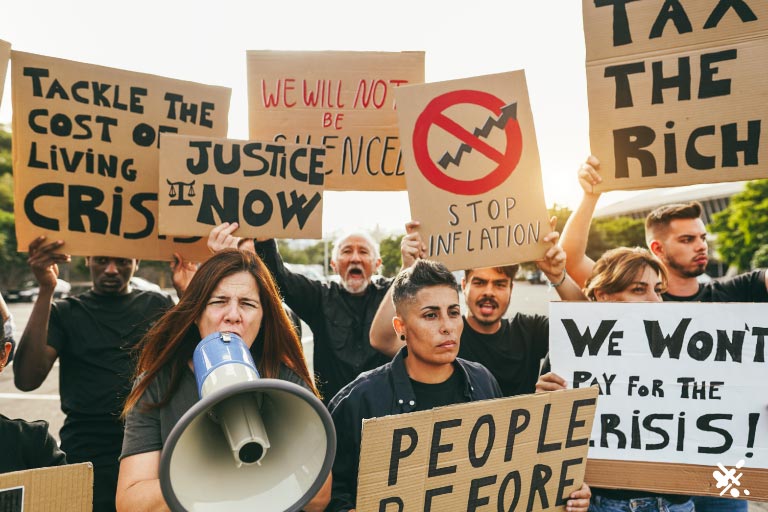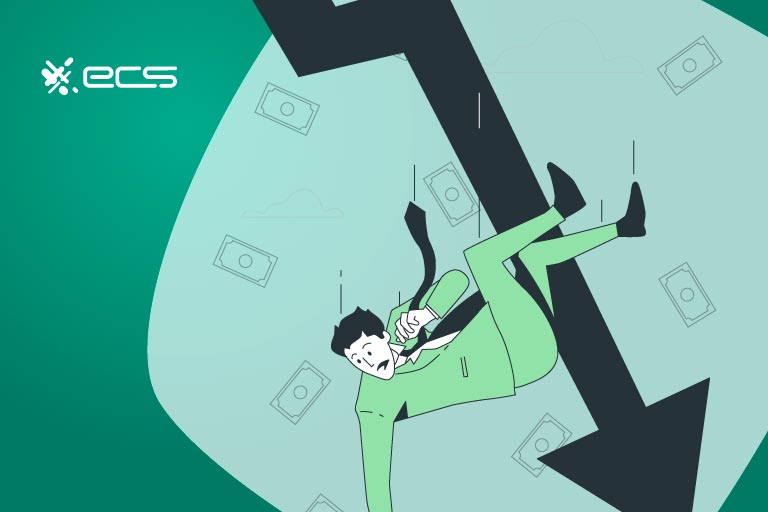You may be experiencing a season where your sales are down. We get it. Cash flow is the lifeblood of any business, and sales are what generate cash flow. But sometimes, just like a ship sailing across the Atlantic, you hit the doldrums. This no-wind zone means lifeless sails. And in your case, it means cash flow slowing down to a trickle.
This type of situation is not sustainable in the long run. Or in the short run, really. The average median business keeps about $12,100 in reserve. A drop in sales can be deadly, as these typical reserves only cover 27 days. If the sales decline isn’t reversed, business can suffer.
What Are Typical Reasons For Low Sales?
Sometimes decreasing revenue is just seasonal. For most retail businesses, the holiday season is the best time of year. Consumers are out shopping for gifts. In fact, the average American family spends about $1,000 on Christmas, 65% of which is allocated to gifts.
While November and December are practically on fire (not literally, but in terms of net income from sales), the months after the holidays are remarkably dull. January and February are fairly lifeless, seeing significantly lower sales.
But one man’s trash is another man’s treasure, as they say about the dumpster behind your local Pizza Hut. January and February are sizzling months for the fitness business. Sales going up are attributable to those New Year’s Resolutions. And certain service-based businesses will see an increase in sales during this time, such as accounting firms. It’s tax season, baby!
In the travel industry, fall and spring are typically slower months. It’s rather ironic because most tropical destinations actually have the best weather during these months. But no matter…kids are in school, making families have limitations on those travel plans.
Take note: if you want to enjoy Bermuda, the Maldives, or Hawaii, visit in March or September. Crowds are small, rainfall is at a minimum, and the weather is perfect for the beach or pool.
Of course, the downside here is borne by the hotels, restaurants, airlines, booking agencies, and local economies that thrive on tourists. All of these businesses will see their revenue decrease in these cooler months (figuratively and literally).
In conclusion, the likelihood of a sales drop really depends on the goods or services you sell. Or does it? Could there be other factors?
Indeed, there are.
Rising Prices, Falling Sales
Traditionally, the number of units sold can lower the costs of goods sold. But what happens when the price of raw materials goes up? Businesses need to raise their prices. And higher prices can sometimes result in decreased gross sales revenue.
During (and coming out of) the Covid Pandemic, the raw materials that go into construction skyrocketed. The wholesale cost of plywood per thousand square feet jumped from $400 to $1500. With a 375% increase like that, it’s no wonder that new home construction fell. This trend has continued despite some brief bubbles of heat.
Industry experts have cited stubbornly high construction costs (e.g. raw materials)and some other factors like increased mortgage rates and inflation. Although a home is the single largest purchase that most consumers will ever make, this is quite reflective of the economic situation at large: stagflation.
Stagflation is a combination of a recession and inflation. To put things in very simplified terms, think of consumers losing their jobs (less purchasing power) and products having elevated sticker prices. It’s a horrible combination for everybody involved.

Strapped Consumers Are Making Difficult Choices
Consumers are paying 33% more for eggs. 21% more for butter. 19% more for flour. 18% more for chicken. 16% more for milk. 14% more for baby food. 6% more for vegetables. For everything else, there’s Mastercard.
Joking aside, an increasing number of consumers will have to use credit in order to keep up with living expenses. And some of them will just drop discretionary purchases while downsizing on necessary staples. There’s a decent chance your business will be impacted by significantly reduced discretionary incomes.
In fact, inflation could cost the average family $11,500. Even more conservative estimates suggest increased costs of around $400. This number is quite dismal, for families…and for businesses that rely on them for cash flow.
Admittedly, macroeconomic conditions are outside of your control. While much ink has been spilled on the causes of this historic inflation, we can all agree that it (probably) has nothing to do with Kanye West and his album sales. It seems like there is not much to do about inflation but wait it out. Revenue recovery will come for those who wait. Or will it?
Around 400,000 businesses permanently closed their doors during Covid, putting 6.2 million people out of work. While that example is a little more extreme, it illustrates that passively waiting out a dull period may not be the best idea. So what can you do?
How Do You Find Sales Revenue?
Enough talk. It’s time for action. What’s more important than asking why sales have decreased, is asking what causes sales to increase. As it turns out, the path to recovering revenue involves some of the same strategies you should use anyway, all year round.
Admittedly, you may have grown lax in your marketing and business growth efforts. With so much to do, it can be hard to keep up. But, if sales are declining, it’s time to go red alert. Below are some strategies that can help you to seek out revenue.
Drop Your Prices…But Only For A Short Time
This will get those customers coming around again, fast. When entering a new market, this strategy is referred to as penetration pricing. It works because even if a business has little in the way of distinguishing itself from branded competitors, money talks.
So even though your average price of services and your price per unit may be lower than your leading competitors, the fact is that 90% of consumers are willing to invest time hunting for the best deals. Around 86% of them will compare prices of the same item from different sellers. And 60% of them consider pricing to be THE decisive factor in a purchasing decision.
You don’t have to keep these prices low forever. In fact, making them low for a certain period of time capitalizes on the psychology of scarcity. NOW, for the next 72 hours, our entire inventory is 50% to 75% off! Phrases like that are going to amp up the sale of goods.
Offer Promotions and Coupons
In a similar vein, offering promotions can generate more sales. There are a number of ways you can go about this. BOGO or buy one, get one free is a popular option. Buy one, get one half off is another commonly used strategy.
Percentage discounts, dollar-amount discounts, and free shipping (for eCommerce) are other options for boosting sales. Bundles are another effective promotion strategy, where several similar items are packaged together for a discounted rate.
It’s often possible to tie your promotion into an upcoming holiday like the 4th of July, Labor Day, or President’s Day. This can generate some additional excitement around the sale, and provide some substance for the marketing material.
Around 70% of consumers reported using an emailed coupon within the past week, and 75% of consumers admit to scouring their email inbox for a coupon. That means seven out of ten consumers are already looking for you. Give them something to look for with a coupon.
Spread the Word
Both of the aforementioned options are useless if you’re relying on foot traffic to spread the message. You’ve got to get the word about discounts out to your customer base. And that means you need to have access to your customers.
This is one reason why it’s important to have some sort of CRM (customer relationship management) software. Contact information like emails and phone numbers can be collected when customers check out or call in for customer service. You can use this contact info to send an email campaign or text coupons en masse to your customer base.
Solutions like MailChimp and ConstantContact make emailing customers in bulk a breeze. And solutions like Avochato allow you to group text customers. If you have physical addresses, mailed ads are also extremely effective.
Your best bet is to use a mix of multiple methods for contacting your customers. If you can email, text, and send paper mailings to your customers, you’ll have a better chance of encouraging them to act on your coupon or offer.
Obtain Customer Contact Info
If you are a service-based business, it’s unlikely that you wouldn’t have client contact info. After all, you need that information to arrange meetings and discuss business. You may not have these names, emails, and phone numbers compiled into a database, but maybe this is a good time to start.
On the other hand, if you are a retail business, especially a brick-and-mortar business, you may not have customer contact info. Thinking forward, you should incorporate collecting contact information into your sales process. But what about right now?
There are businesses that sell contact lists. You can buy emails, physical addresses, and even phone numbers. There are also companies like Valpak. These companies bundle coupons into envelopes and mail them to consumers.
In Valpak’s case, that includes 40 million homes. A study conducted by Valpak showed that 92% of recipients open the letter, and 81% look at every single coupon inside. Seems like those consumers are actively hunting for bargains…like yours.
Get On the Phone
Overall, the point is that there are ways to quickly assemble a list of potential customers and send out an en-masse print ad, email ad, or text about your promotions. If you have a service-based business, however, or you sell products in a B2B context, you might consider just picking up the phone and contacting people directly.
You can check in with current and former clients and see how they are doing. You don’t need to sound desperate or even make an attempt to sell anything (unless you’re good at sales). Just have a conversation, see how things are working out, and let them know if they need anything that you offer, you are there for them.
Of course, it might happen that in the course of the conversation, you uncover a problem that you could solve. At this juncture, you could mention your services and see if they are interested. If you’re not such a salesperson yourself, you can have one of your more relatable employees dial the numbers. There are also lead generation contractors you can hire on your behalf.
However you do it, direct sales is a simple approach that can bring some rain into a dry spell. While it’s not so effective in B2C settings for small ticket items, it can be very effective for service-based businesses or with former or current B2B partners.

Hold Events
It’s time to think outside the box and have a little fun. 93% of polled consumers say that live events are more impactful than other advertising methods. And a whopping 96% of consumers attending an event are motivated to buy an affiliated product or service. 54% of these attendees actually make a purchase, and 75% actually become long-term customers.
An event does not have to be a six-figure catered event in a white tent with fireworks, live music, and a chocolate fountain. An event can be as simple as keeping your store open two hours past its normal closing time, serving some appetizers, hosting an open bar, and showing a movie or having a speaker come present.
In fact, this type of marketing strategy is standard fare for many local businesses, especially art galleries, and restaurants. Downtown associations and local chambers of commerce sponsor weekend events like street fairs of “First Fridays.” These pedestrian-friendly events encourage participants to browse local businesses, eat local food, and enjoy an immersive experience.
If you are a service-based business, your event could be a presentation or a lunch-and-learn. Reach out to your network and see if anyone would like to host you as a speaker to discuss tax strategies, retirement planning, hair styling, nail painting, or whatever you do. At the end of your presentation, you can hand out business cards and perhaps make some new clients.
But what if your business is online? This leaves you with little recourse to hosting an in-person event. Even if you’re a service-based business, your network may be too remote and spread out to effectively find a speaking venue. That’s where the interwebs come in.
Get on Social Media
Take your event digital by doing a “live.” A live or live stream is a live video of you, talking or doing something. Facebook, Instagram, and YouTube are all platforms that allow you to do live streams with minimum or no requirements. All you need to do is use your phone, tablet, or computer for videoing your live stream.
Don’t be afraid to have fun with it. Why not? Social media users have come to expect a certain lo-fi, authentic quality to their user-generated content. You could invite a guest for an interview, conduct a raffle, answer questions, present your latest products, or even just ramble about life over a glass of wine.
You may be surprised, but consumers respond positively to live streams. 80% of polled consumers would rather watch a live stream over reading a blog post. Live streams bring a human touch to marketing that is very real and relatable.
Let’s suppose you have a furniture store. Several days before your live stream, you will post on all your social media channels, several times a day, the day and time of your live stream. When the big day arrives, it might look something like this:
You invite a local carpenter to build a rocking chair inside the store. After he’s done, viewers can type in questions about woodworking. You tell all your viewers that everyone who places an order (online or in person) within the next 48 hours will be entered to win this rocking chair.
There is no exact formula you need to follow, but here are a few guidelines: announce your live stream beforehand. Do it at a time that makes sense for your customers. Make it engaging. And create a call to action, possibly using incentives.

Give Stuff Away
In a related vein, you can give stuff away to incentivize sales. These are called doorbusters, and they’re commonly used as incentives during the holiday season. These should be small prizes that can incentivize a visit to your store. In eCommerce, it is only functional to give doorbusters away at checkout, once the order is placed (sending them with the order).
But in retail settings, you have some leeway to decide when you give the doorbuster away. Do you give it to customers right when they enter the store, or at checkout? Some businesses prefer to give items away at the door. Candy stores and bakeries are two common examples.
Speaking of which, studies have shown that food is incredibly effective when it comes to free samples. A consumer survey of increase in sales after free samples found that frozen pizza sold 600% more, beauty products about 550%, wine over 300% more, beer about 60%, and packaged cheese over 100%.
This might be because food creates a sense of instant gratification. But beauty products do as well. This is why so many department stores have an army of makeup reps putting lipstick, eyeshadow, and makeup on shoppers. It’s also why Costco hands out so many free samples. Giving things away works—especially when they generate instant positive feelings.
Rollout a Loyalty Program
Another way to increase sales is to introduce a loyalty program if you don’t already have one. And if you do, marketing a renewed push of this program can go a long way. Loyalty programs are incredibly effective at building consumer loyalty to your brand, in the long term.
Loyalty or rewards programs vary in the details, but generally speaking work like this: every time the consumer shops at your store or spends a certain amount, they get points toward a prize. The prize could be something free or a discount. Once upon a time, businesses used punchcards to keep track of points. But these days there are software solutions that create a better customer experience (and are less prone to hole-punch fraud).
Loyalty programs have been found to boost revenue by up to 20% (or more). 50% of participants in a loyalty program recommend that brand to their friends. 60% of these participants say they have a better customer experience. And 84% of loyalty program participants are more likely to stick with a brand.
Loyalty programs are not only a short-term way to boost weak sales, but also a long-term plan for boosting your revenue. They can also help you boost sales in a slump by doubling incentives or offering extra points when business is slow.
Reflect on Your Customer Service
A significant amount of churn is caused by poor customer service. 73% of customers will not hesitate to switch brands after a bad experience. Inversely, 91% of customers would consider making additional purchases after a positive customer experience. And 78% of customers would be willing to forgive a company for its mistakes if they have good customer service.
How is the customer service at your business? If you don’t have a sense of that, do some eavesdropping (legally) on customer-employee interactions. Also, take a moment to consider how accessible your business is to customers in need of help. Put yourself in a customer’s shoes and try to reach your own business.
Is the path to help clear? Can your customer care phone number and email be found on your website, social media pages, and product packaging (where relevant)? If not, this is likely leading to lots of customer frustration and abandonment.
Declining Sales: A Wrap-Up
Coupons, promotions, events, giveaways, social media lives, loyalty programs, competitive pricing, and direct sales… are just a few strategies for boosting your sales quickly. The one thing they all have in common is action. You cannot wait around for business to sail out of the doldrums, especially in today’s lackluster economy.
At the heart of many of these strategies is a POS system. That’s because many of these strategies rely on applying discounts or reduced pricing. The software provided by a good payment processor can facilitate building these discounts immediately into your register.
That in turn will take a lot of manual work behind these promotions away. If you’d like to learn more about how payment processing fintech can assist in turning your sales volume around, give us a call or fill out the contact form below.
